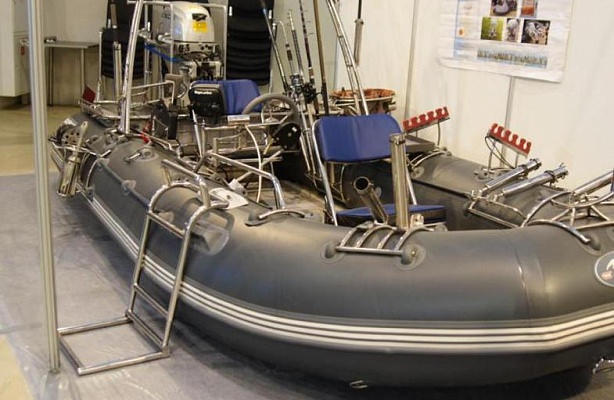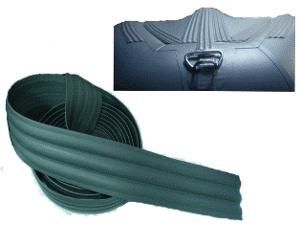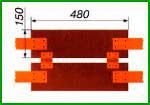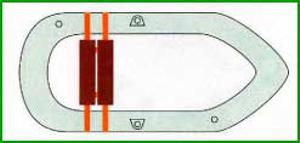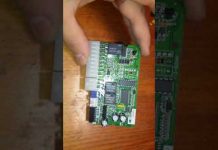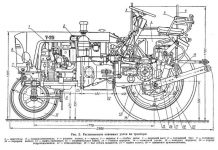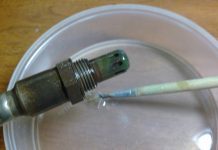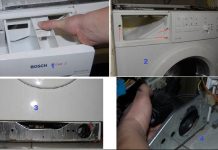There are many models of boating anchors. Most fishermen often use any iron device of suitable weight as an anchor. Some fishermen prefer to buy collapsible models.
It is more expedient to make holders for spinning on the basis of plastic tubes. It is desirable to have 2 holders on each side.
The echo sounder sensor can be fixed with a suction cup, but in most cases on PVC boats it does not hold well. As a solution to the problem, you can purchase an aluminum tube with a square cross section. We drill holes (through holes) in the tube for the pin.
We make an eyeball egg and fix it with glue in the side upper area of the balloon.You can adjust the immersion depth of the sensor by gently moving the pin. We equip the lower part of the tube with a bracket for the sensor. By rotating it vertically, you can achieve the required level of inclination. Horizontal rotation is impossible due to the profile pipe.
There are a lot of options for creating transom wheels. The main purpose of the wheels is considered to be the transportation of a laden watercraft from the trailer to the aquatic environment.
Most of the shop models of PVC boats are equipped with hard seats, which deprive the angler of comfort and do not allow him to sit comfortably for a long time. To ensure your own comfort while on board, you can install soft seats on board, previously upholstered with leatherette.
Alternatively, you can purchase inflatable chairs. If desired, the padded seat is complemented by a bag located underneath and serving as a storage for small parts. The size of the bag should be in proportion to the size of the chair.
Unfortunately, it is impossible to predict what might happen to the boat after going out into the open water. Quite frequent troubles for fishermen are unexpected collisions with obstacles. In this case, a poor clamping of clamps can provoke a breakdown of the outboard motor from its location. Very often, he simply goes to the bottom of the reservoir.
To eliminate this kind of misunderstanding, you should start strengthening the motor. For this, a cable (synthetic or steel) is pulled on the transom bypassing the eye-rings that are located on the transom. In simple terms, the motor is securely tied up and it becomes impossible to lose it.
When tuning a boat, anglers often equip an awning on it. Awnings are available in a variety of varieties and can be tailored to specific boat models. For small boats, umbrella-tents are usually used, which shelter a person from rain and sun.
To store useful little things that can come in handy on fishing, bags are actively used. They can be placed in the bow of the boat or under the seat. To secure the bag, use the basic boat hardware. You can build a small comfortable table on the boat from a highchair (part of a plastic table).
As an additional tuning, anglers attach the gas tank and equip the boat with an arc for spinning.
Fastening the gas tank is a very important procedure, which will allow you not to lose it during sharp turns or strong current. Usually, the tank is tied up using a strong rope passed through the half rings.
The anglers call the arc for spinning among themselves a tarka. As a rule, it is performed on the basis of a pipe, attaching a glass securely to install the tackle. The tarka is installed in the transom of the vessel or in the middle.
VIDEO
When gluing the accessories to the inflatable boat, it is necessary to use a high quality adhesive base (specialized).
Before starting bonding, be sure to degrease both surfaces.
Each of the layers of glue is applied after 15-20 minutes, which is necessary for the glue to polymerize.
The purchase of a PVC boat, regardless of the purpose for which it was made, whether it will be used for surface fishing, walking on the water surface, or sports rafting on rivers, is a kind of celebration for its new owner.
Basically, boats are on sale, so to speak, of the basic configuration. This means that the kit includes: a PVC boat, on its basis safety cords, attachments for oars, the oars themselves and a packing case are attached.
But, unfortunately, this is very little for its further exploitation. In order to fully experience all the comfort of water swimming, the boat must be equipped with auxiliary elements, and the boat must be tuned.
But not only the purchase of additional equipment for your boat will be the main condition for comfort, but will also increase the percentage of your safety while in it on the water, and can also significantly increase its service life.
The list of tuning items, using which will provide you with a comfortable stay in the boat:
parking anchor;
protective awning;
modernized chair;
bags for storing all kinds of items that you may need afloat;
camping table;
similar staircase;
electric and gasoline powered motors;
sail;
mounts (holders) of rods;
mount for the echo sounder.
This is not the whole list of all items that still give an overall picture of the fact that your boat, thanks to the use of tuning elements, will already become more comfortable.
Of course, it is advisable to put in the first place not comfort, but the safety of people who will be in a swimming facility on the water.
For these purposes, it is advisable to apply:
reinforcement of the bottom of the boat;
making a hard floor;
increase the protection of tanks from damage;
attachment of additional safety ropes;
VIDEO Carrying out the modernization of the PVC boat can be entrusted to specialists in this matter, or independently, do these works with your own hands.
The work performed by specialists is a more expensive option, but it will be done more professionally, faster and of better quality.
Of course, tuning can be done with your own hands, but this requires certain tools, material, you need a place where the alteration will be made, as well as have the skills to perform such work. For that, this method is more suitable for many because of the owner's feeling of authorship and its cheapness.
VIDEO Considering the step-by-step implementation of tuning the PVC boat, one must start with increasing the strength of the object.
To do this, we will determine the weak points, which are most often subject to negative atmospheric and forceful influences on the material of the boat.
bottom its outer part very often rubs against the shore, the bottom of the reservoir, against objects during transportation and transportation, and the inner part takes over the entire weight of the equipment;side boards make up the most protruding parts that, in addition to friction, I also feel the destructive power of ultraviolet radiation;tailgate takes on the impressive mass and vibration of the motor.You cannot be careless about the safety of the passengers on the boat. The best option is to use lifejackets or buoys in boat equipment.
The equipment is protected by awnings and covers made of dense moisture-resistant foam rubber with an inner base from mechanical damage.
VIDEO A special part of tuning PVC boats is to improve their comfort and appearance. Each owner of such a water product strives to make it unique, more adaptable and practical.
Boats are equipped with comfortable soft seats, since a long stay almost motionless sitting on a wooden standard seat makes the pleasures of being on the water in agony.
Strengthening various bags and containers makes it possible to keep things necessary for a person in a certain order and protected from rain and ultraviolet radiation.
The possibility of attaching electric and gasoline motors makes it possible for a PVC boat to become high-speed and maneuverable. For a more stable relationship between boats and water, an inflatable cue is made.
Boats without an inflatable cue, equipped with a motor and having a length of more than 3 m, may capsize during acceleration and headwind.
Equipment fixed on board:
rod holders
echo sounders
landing net clamps
bait and bait containers
become one of the convenient and important attributes of fishermen.
VIDEO Performing all work on the modernization of your boat requires a verified location of the necessary objects on board. Beforehand, it is imperative to make marked markings of future parts, so that each of them does not interfere with the installation of the next one.
The use of quality materials will give a positive result and will clearly and reliably correspond to their purpose.
In this article, we introduced you to some of the useful features of PVC boat equipment and pushed you to new ideas for improving them.
When the boat has already been selected, then, as a rule, upon sale you will be offered to conduct tuning boat ... What does it include, and how much do you need this whole range of works?
The boat that leaves the production hall carries only the minimum of everything that is necessary for its operation.She, of course, can be used normally in this form, but will such exploitation bring maximum positive emotions and will it give you a feeling of comfort on the water in terms of the level you expected?
Based on more than thirty years of practice of using small boats, the answer is obvious to me: no, for the overwhelming majority of shipowners it will not!
After the very first out on the water, having looked at the boats of colleagues, you will want to adapt the boat to your tasks as much as possible. And first of all, as much as possible / * insure against unforeseen circumstances. Why such confidence? The boat does not always leave in good weather and return to the shore in calm weather. Variants are possible. Therefore, it is reasonable to direct the first steps in retrofitting a boat to increasing the level of its safe operation, so that it can forgive you mistakes as much as possible.
There are known cases on the water, when the motor rips off its regular place and, in parting, having time to strike a couple of times on the end switch of the cylinder with a screw, disappears into the abyss of waters. In reality, there are several reasons for such events - from violations of the rules for operating the vessel by the skipper, hitting an underwater obstacle to wear or tear of the transom linings, breakdown of the engine clamps.
The easiest way insure the motor by means of two eye rings (eyebolts) symmetrically installed on the boat transom. After installing the motor, they are interconnected with a strong steel or synthetic cable so as to capture the deadwood of the motor, but also not to prevent the motor from reclining freely in the event of a collision with an underwater obstacle.
Such a fixation, in my opinion, should be provided for in any boat, despite the various options for the floorboard or inflatable bottom. Having secured the gas tank in place, you can not worry about its safety and location, even in stormy weather. It is more convenient to carry out any fastening in the boat with the help of half rings and slings. Depending on the type of bottom, the half rings can be installed using [screws, self-tapping screws, or glued using special overlays. Exactly the same mounts can be placed in any part of the boat's cylinder to fix any equipment and inventory. In this way, you can unfasten small bags, sealed packaging, tubes with spinning rods, and, most importantly, an anchor, securing it with rings against spontaneous falling overboard.
The boat is moored to the shore. There may be several such mooring lines during fishing. If the coast is a sandy or rocky shoal, then any, even the most gentle contact of the hull with it during mooring will leave marks on the boat. The accelerator, if you will - the catalyst for wear, will undoubtedly be waves. Regular dragging over sandy and rocky spits or shallow water can also quickly wipe off the PVC layer on the bottom. All this gives reason to think about the maximum reduction in the likelihood of damage that is caused to the bottom by such abrasive abrasion.
To reduce the consequences of this phenomenon, the bottom reinforcement system has been worked out. It boils down to gluing along the entire bottom or in places that most often encounter obstacles during movement, an additional layer of PVC. It can be either an additional layer of fabric or a profile molded from PVC.
It is clear that any such reinforcement will inevitably lead to a certain increase in the weight of the entire structure, which at high or extreme loads of the vessel can already be very critical. The width and thickness of the profile for reinforcement are different. The general selection criterion is the weight of one running meter; it usually ranges from 70 to 350 g.
It should be noted one design feature of boats with an inflatable bottom. Since there are no rigid elements on the bottom, there is no need for this type of protection. And on boats of the catamaran type, a kind of shell protection was already initially laid down by the manufacturer.Boats of this type, when mooring, come into contact with the shore surface exclusively with skegs / additional cylinders inside the protective covers.
If the boat is being prepared mainly for trips on rapids as a floating vessel, then the reinforcement for safety reasons should be maximized.
If exploitation is to be carried out in ordinary lowland waters, then it is possible, as they say, to get off with "little blood".
And one more argument in favor of installing protection. When the bottom part of the boat is worn out, it is much easier and cheaper to replace the PVC profile when wiping, than to patch or even change the entire bottom sheet.
And now in a little more detail on which routes should be laid reinforcement on boats with a rigid floorboard.
Usually, the keel manufacturer lays only one tape of the so-called "halt" (the manufacturer's term for a profile molded from PVC).
If you glue one more tape on both sides of this profile to the transom itself, then such protection will reliably protect not only the bottom panel, but also the keelson.
The next element, which also wears out noticeably, is the balloon. Therefore, halting its lower surface is the second stage of reinforcement. It can take from ¼ to ¾ the length of the cylinder, counting from the stern, that is, only that part that is subject to wear. It is also recommended to reinforce the stringers.
And why is it actually needed? Unlike rigid hulls, a PVC boat is noticeably deformed during movement and the shape of its inflatable elements changes somewhat. Only rigid elements of its structure are subject to minimal deformation - the bottom hole and the transom. The tight contact of the transom with the balloon and the bottom is ensured by the strength of the gluing on the profiles or tapes. In contrast, the bottom liner is only inserted into the cockpit and installed in the spacer between the cylinders.
The places where the rigid floorboard or stringer touches the fabric of the cylinder or the bottom are the most vulnerable when the boat is moving. Especially if some kind of abrasive, such as sand, gets here. Without proper protection, the effects of such an “abrasive attack” can take place very quickly. Therefore, the installation of protection in these places is also justified, both inside the boat with appropriate tapes or overlays, and outside the boat, in the form of a PVC profile.
And one more necessary type of protection is protection against floorboard joints. PVC strips are installed underneath the floorboard sections.
And we are completing the complex of works on strengthening the transom. Structurally, in this place, only a layer of the bottom sheet is glued to the plywood.
Reinforcement along the transom is made with a low-profile cast halt or a special corner profile so as not to create additional resistance.
You can do the reinforcement work yourself if you have experience in handling PVC and you are far from service centers. Moreover, all the elements for this and for many other works with the boat, including glue, can be purchased in the stores of a number of manufacturers. Such kits for independent creativity have become quite widespread under the name "Tuning kits".
If the service is nearby, then you should entrust the work with the boat to professionals.
This is the starter complex that will significantly extend the life of your boat.
The next group of useful little things can be described as increasing the level of comfort on board.
Now let's see what else is in the manufacturers' store. What other devices are there that make life easier for a fisherman, hunter or just a rest.
They can be both self-made from improvised means, and industrial production. They can be used both as independent devices and together with a waterproof bag. In this case, the bag with zippers is fastened to the cover and placed under the jar. The volume of such bags, depending on the boat model, is determined by the width of the cockpit and the width of the can used. A very useful device for storing small items, as well as those that moisture can spoil.
To get a little more comfort, inflatable seats are offered for use. These are inflatable ottomans of various shapes and sizes that can be designed to be placed in any part of the boat. They can be fastened both in space between the cylinders, and with the help of all the same half rings.
Even more comfort in the boat can be obtained by installing inflatable backrests for ottomans.
The result is a luxurious inflatable chair, which, however, relaxes rather than allows you to focus on fishing.
A canopy for small rowing boats resembles an umbrella in function, providing protection from the sun rather than rain.
There are several types of awnings for motor boats, which, in my opinion, deserve special attention, because they are very functional products. And they can be partially categorized as safety enhancements in a boat.
Let's start with the awning, which acts as a nose cone. With some skills in handling a sewing machine, it is easy to do it yourself.
Most manufacturers have it in two forms: entirely made of thin PVC fabric and with a transparent window in the front. The awning is quickly installed on a U-shaped arch and stretches along the side berth on hooks. It protects the crew very well from splashes, and the boat from being flooded through the bow by a steep wave.
If the tail number is covered by the material of the awning, then a transparent pocket for the double number must be sewn on the side of the awning.
The cockpit of the motor boat can be covered entirely with an awning. It is made from Cordura or Advice, less often from 350-550
- The base of the awning - U-shaped aluminum arches, which are attached with bolts or screws to special eyelets, molded from PVC and installed on the boat's cylinder. The design is quick-detachable.
- When raised, it allows the crew to take shelter from the weather. The main purpose is to protect against dust and precipitation at the ship's anchorage.
- Due to the presence of transparent windows under the awning, it is possible to move under a motor in a displacement mode. Due to the large windage, movement under it is possible if there is no strong wind.
- Fixation of the lateral sides in the lowered position is carried out with zippers, and in the raised position - on special slings. The sides can be lifted in any quantity and in any sequence. Most comfortable - under an awning with ventilation windows.
Video (click to play).
A somewhat less common type of parking awning, which is created on the basis of collapsible arcs (the design is similar to modern tents).

